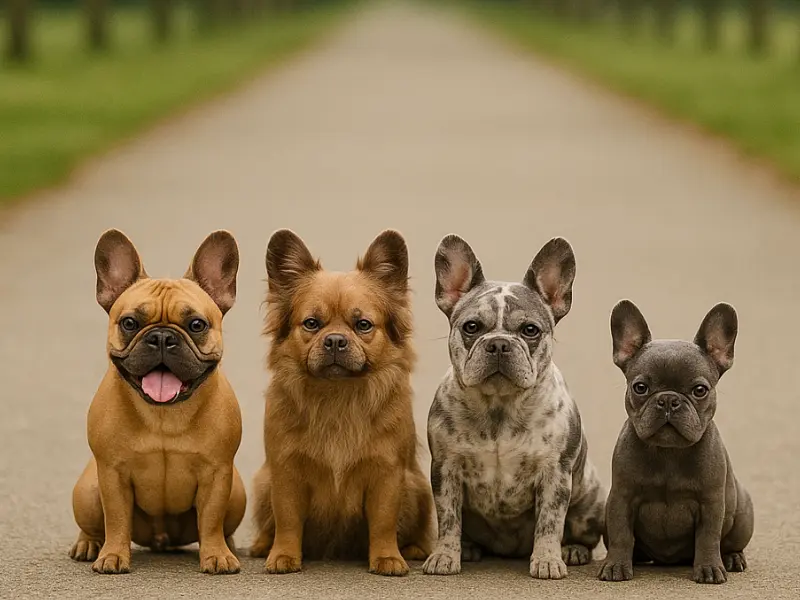
The French Bulldog stands out as one of the world’s most iconic and easily spotted dog breeds. With its big eyes, compact physique, and pleasing bat-like ears, this small canine has stolen hearts all over the continents. The French Bulldog fits in whether you live in a modest apartment or a big home because of its flexible nature and loving personality. Originally developed to be a companion dog in England, then later propagated in France, this breed was meant to be so. They benefit from human contact, love cuddles, and have a funny,
playful attitude that makes them impossible to resist. Franchise posture themselves with a sure, occasionally humorous, attitude, even if they are little dogs are known for being quiet, so they are great for people who live in cities or want a pet that will keep them calm.
Although French Bulldogs don’t need a lot of exercise, they do need your love and attention to stay socially and mentally healthy. Their kind-hearted and sociable nature allows them to connect well with children, other dogs, and houseguests
Their small snouts present breathing difficulties in hot temperatures or during strenuous physical exercise, therefore, some particular attention is required.
From unusual colors to distinctive coat patterns, there is much more to discover about this cute breed—although the traditional look of these dogs is legendary, there are many different types of French Bulldogs.
Here, we will help you to become acquainted with all the several kinds of these dogs and their distinguishing features.
Fluffy French Bulldog
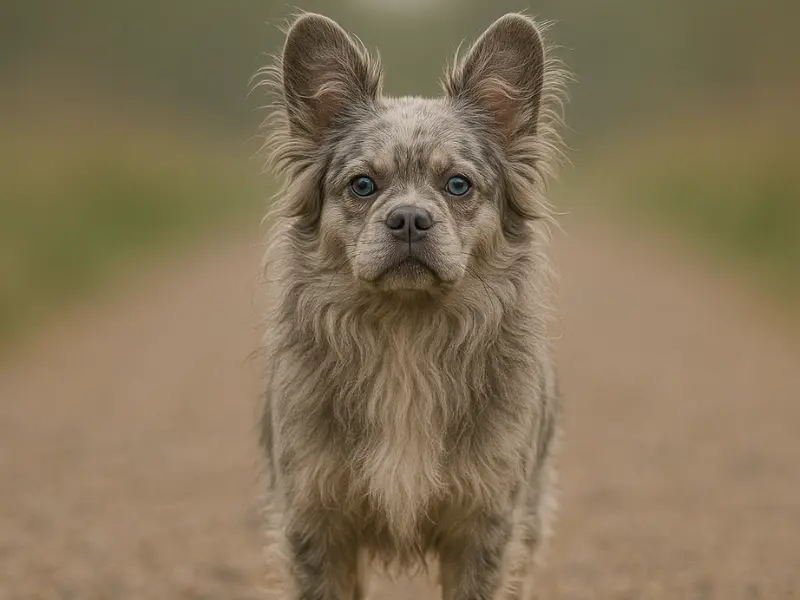
With its long-haired coat strikingly, the Fluffy French Bulldog is an unusual variation of the well-known breed. Unlike conventional ones, whose sleek coat results from a recessive gene sometimes showing deep in the breed’s lineage, these dogs have great fur. Because of this rather rare genetic characteristic, their fur grows rather long, giving them a soft, luxurious, fluffy appearance similar to tiny cuddly stuffed animals or teddy bears.
Origins and History
During the Industrial Revolution in the 1800s, English lace artisans introduced a small bulldog-like dog to France, which is when the breed now known as the French Bulldog got its start. It was further refined by French breeders who focused on its petite stature, bat-like ears, and gentle nature. The dog quickly gained popularity across Europe and eventually became a beloved companion worldwide.
Due to a recessive long-hair gene, this dog is an officially recognized variant that appeared much later—occasionally shows up in litters. For many years, these dogs were considered genetic anomalies, as major kennel clubs like the AKC did not acknowledge the trait. Breeders also typically did not prioritize it. However, with rising demand for rare and unique pets, breeders began intentionally producing fluffy-coated dogs, all while carefully preserving their health and sweet temperament.
Characteristics and Temperament
Though their coats vary, Fluffy French Bulldogs share the same kind, energetic, and loyal personality as the traditional Frenchie. They are excellent buddies noted for their loving nature and ease of adjustment to apartment life. Daily brushing is among the extra grooming care their longer coat calls for to help prevent mats and tangles.
Is the Fluffy French Bulldog the Right Dog for Your Home?
Whether or not to welcome a fluffy French bulldog into your family depends on your way of life and degree of devotion. These dogs thrive in loving surroundings where they get much attention and treatment. Their demands for grooming and care, which some people might not be able to handle. Families, singles, or elderly people who can devote time to grooming needs and appreciate a quiet, loving friend fit for fluffy Frenchies. While they do demand some activity and brain stimulation, they adjust rather well to apartment living. This may not be your ideal pick if you have allergies to dog hair or favor a low-maintenance pet.
Rarity and Cost
These French Bulldogs are somewhat uncommon because the fluffy coat is produced by a recessive gene. Because of their distinctiveness and the additional effort required in breeding and maintenance, long-haired kinds often command a premium price compared to the short-haired ones. Seek out respected breeders who give health testing and ethical breeding techniques top priority if you are thinking about this dog.
Merle French Bulldog

The breed’s rare Merle pattern gives the French Bulldog a look that stands out right away. Dark splotches or patches scattered over a lighter backdrop define this pattern, which produces a marbled or speckled appearance. Because the hues can vary widely, including blue, lilac, and chocolate, every Merle Frenchie is unique. A mutation in the merle gene is what gives these dogs their distinctive appearance
Origins and Genetics
Though it is somewhat rare and regarded as a unique feature in French Bulldogs, the merle gene is a normal genetic variation present in various dog breeds. The merle gene affects both coat color and occasionally eye color since it affects pigment cells, so producing interesting combinations like blue or odd-colored eyes. But given the health hazards, breeding Merle French Bulldogs calls for great care.
Health Risks and Responsible Breeding
Unquestionably attractive, Merle French Bulldogs can have major health problems if not carefully bred. When two merle-coated dogs are paired, the offspring may inherit a “double merle” gene, which is often associated with hearing, sight, and other developmental problems. To raise puppies in good health, breeders must rely on responsible methods and advanced genetic testing
Is the Merle French Bulldog the Right Dog for You?
Should the unique look of the Merle French Bulldog appeal to you, you should be aware of the specific care and attention these dogs may need. Merle Frenchies want owners who will make consistent veterinarian check-ups investments and who are ready for probable health issues. Avoiding the problems connected with merle genetics depends on selecting a trustworthy breeder who does extensive genetic screening.
For families, singles, or seniors, Merle French Bulldogs are great friends since they often possess the same loving, playful, and devoted quality as other Frenchies. Potential owners should be prepared, nonetheless, for the likely additional expenses and medical care.
Blue French Bulldog
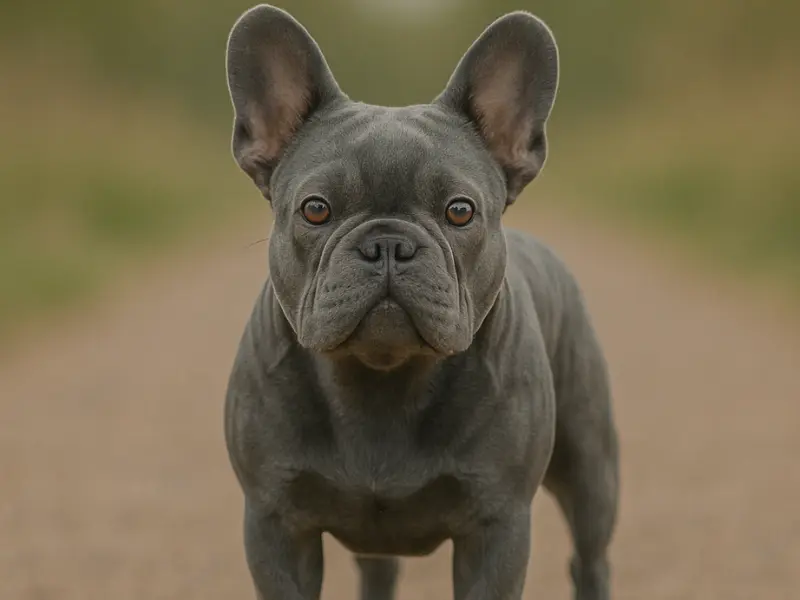
Right instantly recognizable as an appealing variation on the classic French Bulldog, the Blue French Bulldog has a smooth, silver-blue coat. Their peculiar blue-gray appearance results from a dilute gene that reduces the black pigment in their fur, therefore creating this amazing and unique color. Beyond appearances, blue French Bulldogs are known for their quiet, kind, and dedicated nature.
History and Origins
In the 1800s, English lace makers relocated to France amid the Industrial Revolution, sparking the development of the French Bulldog breed. They brought little canines resembling bulldogs as pets. French breeders later polished these dogs into the modern breed. The French Bulldog’s appealing disposition, small size, and bat-like ears helped it to become rather popular.
The breed developed its blue hair hue considerably later on. The cause is a dilute gene, a harmless and natural genetic change. This gene modulates the color of the coat, therefore transforming black fur into blue or gray tones. Although some large kennel organizations often reject blue, pet owners adored it immediately because it looked so sophisticated and unique. Selective breeding helped this unusual color become more prevalent, but breeders had to be careful. The dilute gene links a skin condition known as Color Dilution Alopecia (CDA). CBD might cause skin issues and hair loss if not used as advised. Responsible breeders should reduce the possibility of hereditary issues using health checks and cautious matching.
Appearance and Personality
The Blue French Bulldog shares the same compact, muscular build as the standard variety but stands out with its striking blue-gray, shimmering coat. Their dark, expressive eyes often give off a regal and captivating presence. Personality-wise, these dogs are cherished for their loyalty, calm temperament, and friendly nature. They adapt well to apartment living and thrive on spending quality time with their owners, making them ideal companions for city life.
Health and Care Considerations
The Blue French Bulldog requires more attention because of its unusual hair. Dog owners should be aware of Color Dilution Alopecia (CDA), a skin and hair disorder brought on by the diluted gene. Signs include hair loss, bald patches that don’t line up, and sensitive or dry skin. Blue French Bulldogs need to be groomed, have their skin taken care of, and visit the veterinarian for regular checks if they are to be healthy and happy.
Is the Blue French Bulldog the Right Dog for You?
Should the Blue French Bulldog’s unique coat and calm disposition appeal to you, you should be prepared to provide them the extra care needed. They thrive in loving homes where one can carefully maintain their skin and hair to prevent CDA issues. Blue Frenchies are affectionate and easygoing pets, perfect for families, singles, and the elderly. If you want a low-maintenance companion or are concerned about skin issues, however, you could wish to investigate alternative varieties of French Bulldogs.
Mini French Bulldog

Smaller and more portable, the Mini French Bulldog is a variation on the well-liked French Bulldog. Mini Frenchies are meticulously developed to be smaller yet still possess all the adorable traits and loving personality of their larger cousins. Usually weighing fewer than twenty pounds, they Those who live in apartments or wish for a small, low-maintenance pet will therefore really enjoy them.
History and Origins
The French Bulldog breed began in the 1800s when small bulldog-type dogs were brought to France by English lace workers during the Industrial Revolution. The breed gained a reputation over time for its pleasant demeanor, bat-like ears, and compact, muscular frame. The Mini French Bulldog was developed not long ago, since less and fewer French Bulldogs are growing in size. Minis are smaller than standard Frenchies yet still possess the finest features of the breed. Conversely, this movement has raised problems regarding the proper approach to animal breeding. Some breeders create “mini” French Bulldogs by mixing them with other minor breeds or by undertaking dubious activities like breeding run-offs. These behaviors might be quite detrimental to dogs’ health.
Characteristics and Temperament
Both the miniature and standard French Bulldogs are friendly, loyal, and deeply devoted. For single people, couples, and small families, they are wonderful pets since they are intelligent and fit for metropolitan life. Small as they are, they still get some exercise and cerebral stimulation, but require less space
Is the Mini French Bulldog the Right Dog for Your Home?
A Mini Frenchie can be a great option if you want a smaller French Bulldog, perfect for apartment life. But it’s important to select a breeder with a strong reputation who puts the health of the dog first over mere small dog production. Bad breeding can lead to health concerns, including gene defects, respiratory difficulties, and other disorders. Mini French Bulldogs require parents who can routinely bring them to the veterinarian and ensure they get enough exercise. If you want a small but robust friend with a large personality, this breed could be ideal.
Blue Merle French Bulldog
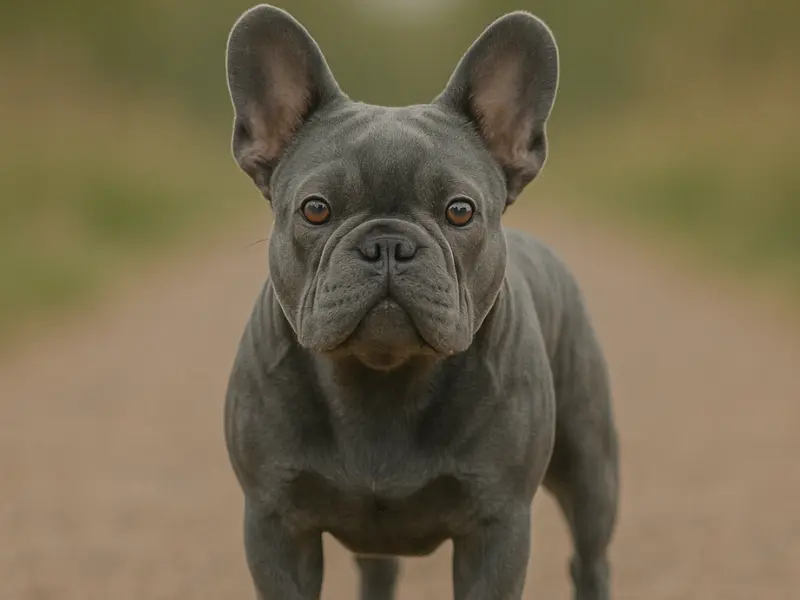
A unique mix, the Blue Merle French Bulldog boasts a lovely coat combining tones of gray, blue, and black. Blue Merle Frenchies have a pattern that distinguishes them among a throng. Those who enjoy distinctive appearances and loving personalities are quite fascinated by dogs.
History and Origins
English lace workers transported tiny bulldog-type dogs to France in the 1800s, hence launching the French Bulldog breed there. The breed gained recognition over time for its small size, ears like those of bats, and amiable nature. Still, the merle pattern is a genetic modification not particularly common. It leaves the hair speckled with varying hue blotches. Blue Merle French Bulldogs have a distinctive marbled appearance since their merle gene and faint blue hair were traits of their breeding canines. Smart breeders make sure to prevent “double merle” couples since the merle gene can be detrimental to your health and dramatically increases the likelihood of birth abnormalities, including vision and hearing problems.
Characteristics and Temperament
People love Bluemerle French Bulldogs for their magnificent, one-of-a-kind coats as much as for their friendly and devoted personalities. They are energetic and friendly, like other Frenchies, which makes them great housemates, single people’s pets, and elderly folks. For those who live in flats, they are also excellent pets as they are flexible and have a low energy level.
Is the Blue Merle French Bulldog the Right Dog for You?
Should you be drawn to the rare and exquisite Blue Merle French Bulldog, you should be aware of their required level of care. Merle genes carry potential genetic hazards, hence, you should be sure your puppy comes from a reputable breeder who practices responsible breeding and extensive genetic testing. Your Blue Merle French Bulldog will be magnificent as a pet if you treat it well. Those who wish to own one should be aware, nevertheless, that their health may be under observation, particularly with relation to their hearing and vision.
Lilac French Bulldog
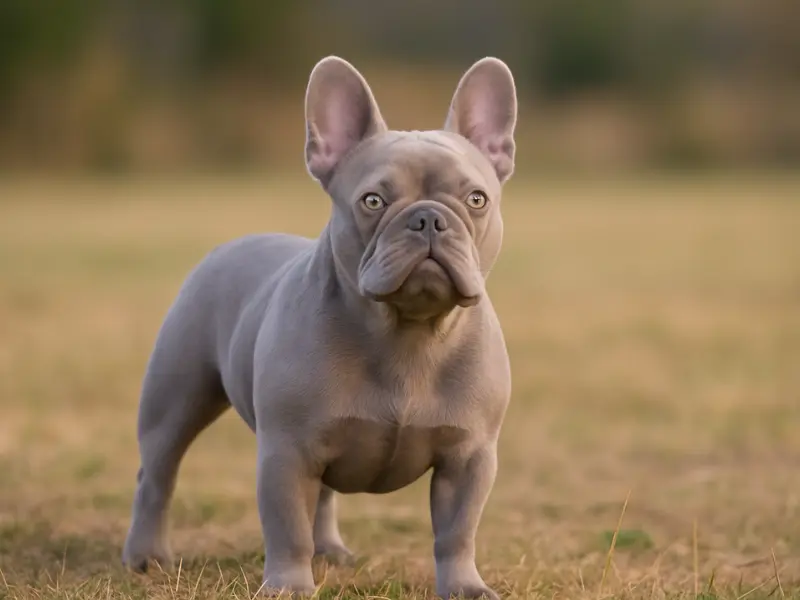
Among the most unique and beautiful French Bulldogs is the Lilac French Bulldog. Their pastel-colored coat results from an odd genetic combination containing blue and chocolate genes. This produces the unusual color lilac or pale grayish-purple. Beautiful light-colored eyes—blue, gray, or amber—that complement Lilac Frenchies’ foreign appearance and accentuate their charm make them even more appealing.
History and Origins
During the 1800s, English lace workers brought small bulldog dogs to France, where they evolved into the French Bulldog breed. The breed gained popularity very fast since it was small, affectionate, and possessed ears resembling those of bats. Rare Lilac French Bulldog hair color results from crossing the chocolate gene with the diluted blue gene. This lends the gentle lilac color. Because their genes are complicated to find, lilac-colored French Bulldogs often cost extra. Breeders of healthy puppies with these exquisite colors have to be honest and give health testing priority.
Characteristics and Temperament
Apart from their great looks, Lilac French Bulldogs are known for their quiet and loving nature. For friends, couples, and single individuals, dogs are perfect companions since they prefer to be with people and are both quiet and lively. Lilac Frenchies have typical energy levels and are usually peaceful despite their unusual appearance.
Is the Lilac French Bulldog the Right Dog for You?
For a dedicated home that values its unique hue and laid-back attitude, the Lilac French Bulldog can be a great pet. Although rare, choosing a trustworthy breeder will help prevent possible health problems connected with them. Lilac French Bulldogs do well in many living environments, including apartments, with regular care, attention, and enough exercise. Different people find that their sociability makes them perfect partners.
Gray French Bulldog
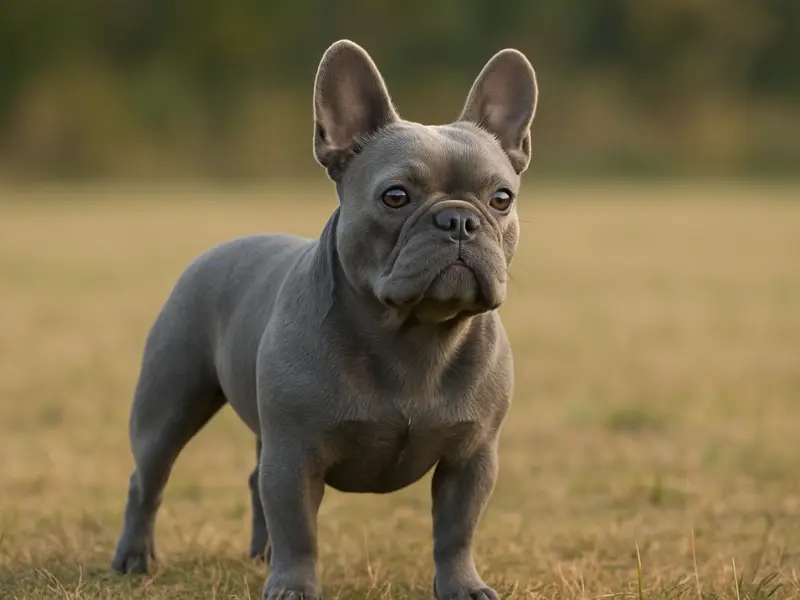
The Gray French Bulldog is commonly mistaken for the Blue French Bulldog because of their similar appearance; yet, the Gray Frenchie has a coat color ranging from silvery-gray to slate. Among these dogs, this beautiful color gives them a muted, elegant appeal. Like other dilute-colored Frenchies, gray French Bulldogs are prized for their quiet and amiable nature.
History and Origins
English lace workers imported little bulldog-type dogs to France in the 19th century, hence beginning the French Bulldog breed. French breeders intentionally shaped the breed to have a gentle personality, small stature, and large, upright ears. The dilute gene causes the Gray French Bulldog color variant by lightening the black pigment in their fur, therefore producing the clear gray tint.
Although some kennel clubs do not formally accept the Gray Frenchie, dog enthusiasts who value its unusual coat color have become rather fond of it. Breeders have meticulously created this range while closely monitoring health to avoid genetic problems connected to faint coat colors.
Characteristics and Temperament
Together with their beautiful gray coat, gray French Bulldogs have the usual strong, muscular frame of the breed. Their cheerful, devoted, and flexible attitudes are well-known. From homes with yards to flats, these dogs fit rather well in several living environments. Like other French Bulldogs, they flourish on family attention and value company.
Is the Gray French Bulldog the Right Dog for Your Home?
The Gray French Bulldog would be a great addition to your house if you like its sophisticated look and loving nature. Gray Bulldogs may, however, be sensitive to skin disorders, including Color Dilution Alopecia (CDA), just as other dilute-colored Frenchies. Their coat will remain healthy only if regular grooming and skin maintenance are followed. Families, single people, and the elderly who can give regular care and attention will find great pets in them. The Gray French Bulldog can be a devoted and delightful friend if you are ready to dedicate yourself to their grooming and health needs.
American Bulldog:
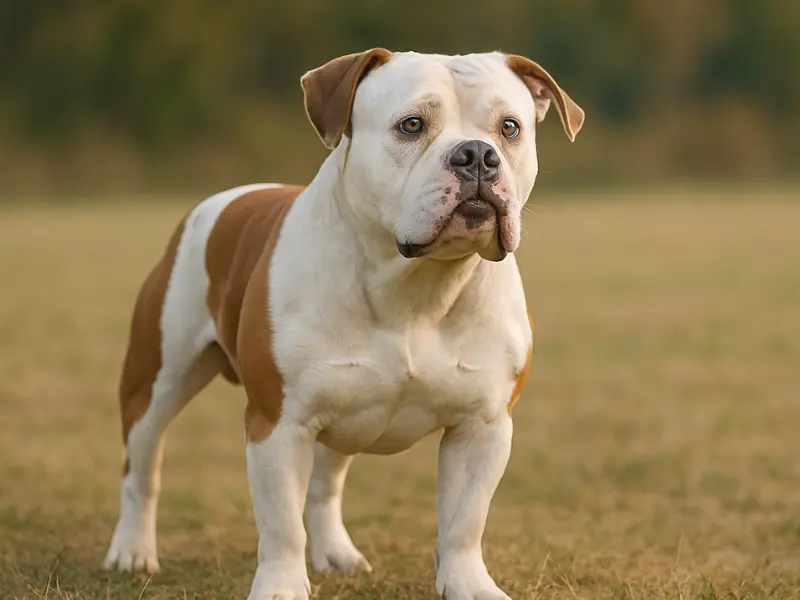
The American Bulldog is a canine breed recognized for its fearlessness, valor, and protective disposition. It is also a dog that is robust and athletic. This breed was originally developed in the United States as a working dog and has an extensive history. Moreover, it remains a favored option for households and individuals seeking a reliable and self-assured companion.
History and Origins
In the early sixteenth century, European immigrants introduced bulldog-like dogs to the United States, resulting in the development of the American Bulldog. These canines were primarily employed on farms and ranches for property protection, herding livestock, and aiding in hunting activities. The breed was developed over several decades to be robust, agile, and resilient for the purpose of performing difficult tasks.
By the mid-20th century, the American Bulldog’s popularity had started to decline; however, devoted breeders endeavored to standardize its traits. With their powerful frames and loyal hearts, American Bulldogs have earned a reputation for strength and devotion
Appearance and Temperament
Their robust body radiate strength and speed, featuring a broad head and formidable jaws. Their coat is short and sleek, available in white, brindle, fawn, and other patch combinations. American Bulldogs exhibit a disposition characterized by confidence, protectiveness, and affection towards their families. Despite their intelligence and trainability, they require continual guidance and early socialization. While they are celebrated for their kindness and playfulness with children, their protective instincts render them exceptional guard dogs. American Bulldogs usually fall within the 60 to 120-pound range, placing them in the medium-sized dog category
Is the American Bulldog the Right Dog for Your Home?
The American Bulldog is a great option if you are searching for a devoted, guarding, and energetic dog. But given their weight and power, they require an owner who can offer lots of exercise as well as strict, constant instruction. Although they can fit many living environments if their physical and mental demands are satisfied, they flourish in houses with yards and a busy family. To guarantee that kids become polite friends, proper socializing and training are necessary.
French Bulldog Puppies
Beautiful tiny bundles of love and enthusiasm, French Bulldog puppies are They need extra care from the time they are born, particularly since their flat faces might cause problems with breathing. Social, inquisitive, and affectionate, Frenchies are a well-mannered dog; it mostly depends on early training and socialisation. Purchase from certified breeders who offer health clearances to guarantee you obtain a contented and healthy puppy.
French Bulldog Lifespan
Usually living between 10 and 12 years, a healthy French Bulldog’s lifetime can be influenced by veterinarian treatment, nutrition, exercise, and genetics. Although they are usually healthy, French Bulldogs are prone to some ailments, including skin diseases, musculoskeletal problems, and breathing difficulty (from their flat facial). A good lifestyle and frequent visits help them stay happy and prolong their lives.
Full-Grown French Bulldog
Depending on genetics and gender. By about 12 months of age, they reach their full size; some may fill out somewhat until 18 months. For their petite body, adult Frenchies are powerful, compact, and shockingly robust. Though they like quick walks and games, they don’t need much exercise. Usually standing 11 to 12 inches tall, full-grown French Bulldogs weigh 16 to 28 pounds.
How Much is a French Bulldog?
French Bulldogs aren’t cheap. Price ranges vary depending on factors such as coloration, pedigree, and breeder quality. On average:
- Standard French Bulldog: $2,000 – $4,000
- Rare colors (like Blue, Lilac, Merle): $5,000 – $10,000+
- Fluffy French Bulldog: $10,000 – $15,000+
These dogs are expensive due to the high demand, costly breeding process (often involving artificial insemination and C-sections), and health testing. Make sure you’re purchasing from a responsible breeder who provides full documentation and vet records.
Final Thought
The French Bulldog, with its many charming variations, continues to captivate dog lovers through its distinctive looks, affectionate personality, and adaptable nature. Whether you’re drawn to the rare Fluffy variety, the eye-catching Merle patterns, or the compact Mini version, each of these dogs has unique traits and care needs. Choosing the right companion means understanding these differences and offering the love, attention, and care they deserve.
Though small in size and friendly by nature, making them ideal companions for both homes and businesses, it’s important to remember that their distinctive genetics and physical features can make them prone to certain health issues. A healthy, happy life for these dogs largely depends on responsible breeding and proper care.
If you’re looking for a loyal, loving, and joyful companion to brighten your days, one of these remarkable dogs could be the perfect addition to your family. Appreciate their quirks, cherish their devotion, and enjoy the incredible journey of life with a truly special furry friend by your side.
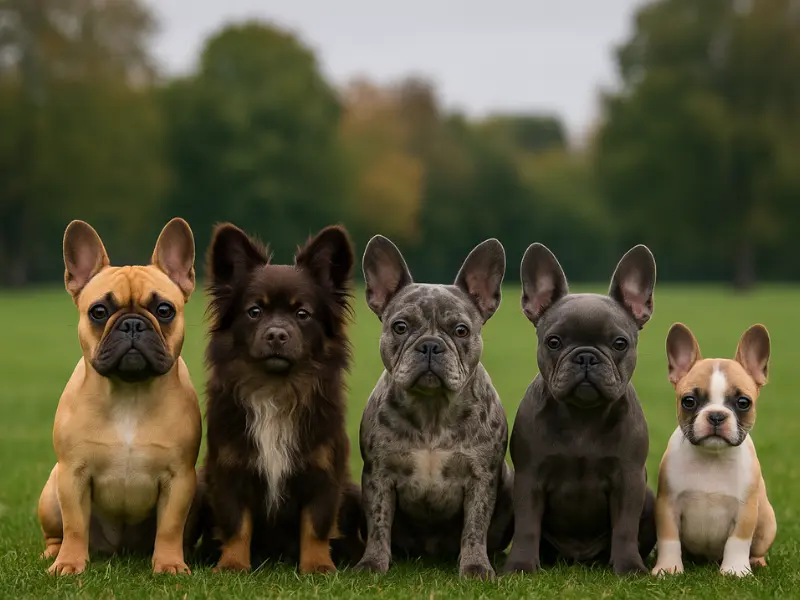
1 thought on “French Bulldog Types, Care Advice & Essential Facts for Dog Lovers”